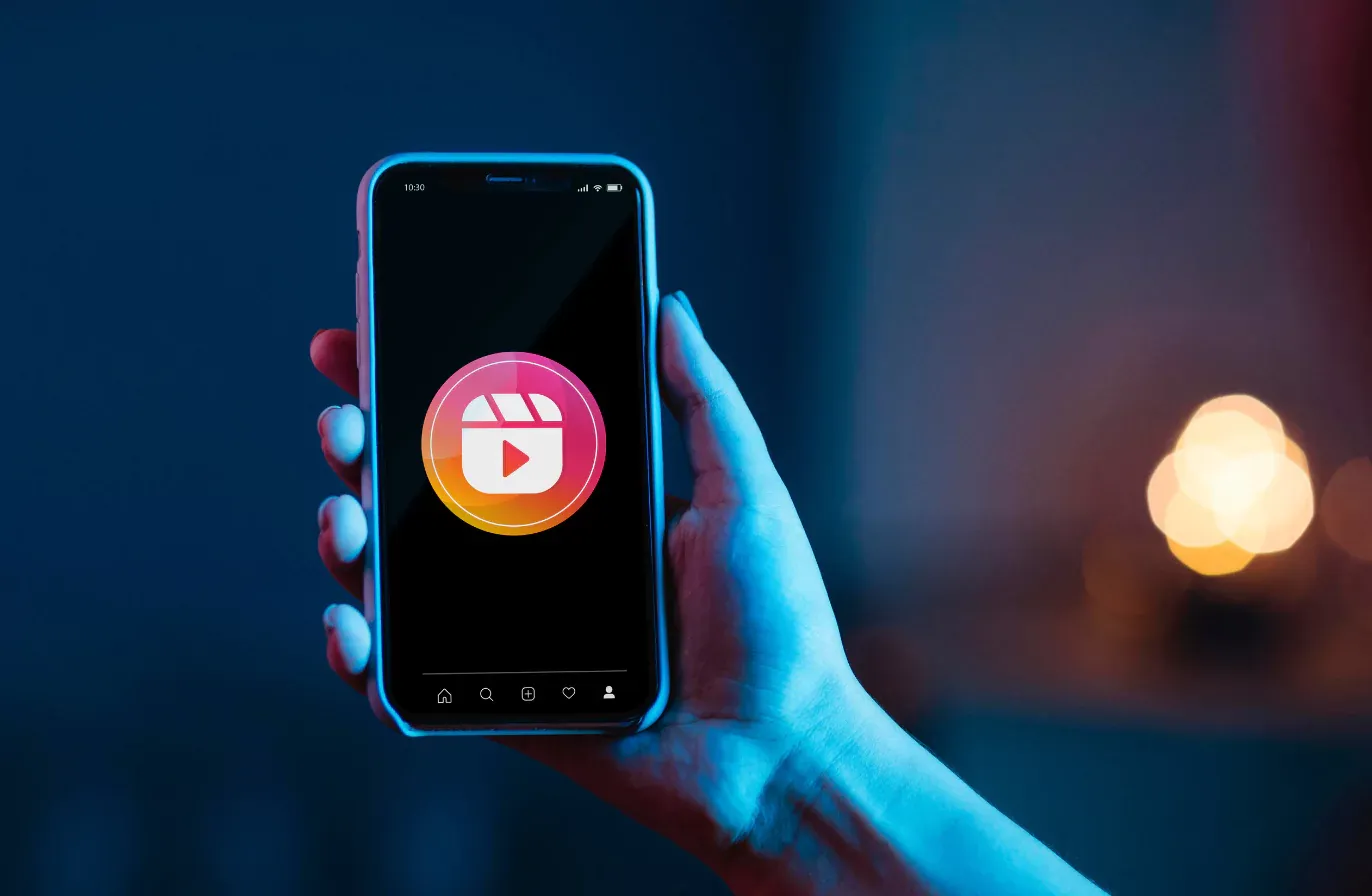Instagram Audit: 10 Essential Tips for Analyzing Your Performance
Curious to see what an Instagram audit is and why you need one? Explore our guide to find out how you can improve your performance.

Ever catch yourself posting a Reel, crossing your fingers, and then watching the numbers trickle in like a slow drip of coffee?
I’ve done it, and honestly, it’s brutal. That’s usually the moment I know it’s time for an Instagram audit that tells me if my bio still sells me, if my followers are real humans, and if my content is actually earning its keep.
In this guide, we’ll explore how to audit an Instagram business account and why it matters. By understanding your Instagram metrics and leveraging Instagram analytics, you can fine-tune your approach and achieve better results.
Key takeaways
-
Set clear goals & KPIs - Define SMART goals to know what metrics matter
-
Audit your profile - Check bio, username, links, CTA, and brand consistency
-
Research your audience - Track follower growth, demographics, and remove fake followers
-
Review content mix - Compare Reels, carousels, and images; identify top-performing pillars
-
Check content quality - Use checklists for Reels, carousels, and images to improve engagement
-
Analyze engagement - Look at rates, shares, saves, and comments for deeper insights
-
Test posting frequency - Find the balance between consistency and audience tolerance
-
Optimize hashtags - Mix niche, branded, and industry hashtags; monitor performance
-
Run competitor analysis - Benchmark against peers to spot gaps and opportunities
-
Compile findings - Create a report with action items and expected outcomes
-
Use tools - Leverage platforms like Socialinsider, Sprout Social, or Iconosquare for deeper insights
-
Repeat regularly - Run audits quarterly (or monthly for fast growth) to stay aligned
What is an Instagram audit, and why is it useful
An Instagram account audit is a complete review of your Instagram content and strategy.
It involves digging into your profile, posts, followers, and engagement to see what’s really working and what’s just taking up space
Here are four key reasons why you should conduct an Instagram audit:
- Catch silent brand drift: Over time, your tone, visuals, or even values can shift without you noticing. An audit helps you spot whether your current Instagram presence still matches your brand identity.
- Uncover content gaps: You might be overusing a format (like Reels) and ignoring others that could actually reach untapped parts of your audience. An audit reveals blind spots in your content mix.
- Spot wasted effort: Some post types may eat up design hours but deliver little return. Auditing highlights where your team’s energy pays off and where it doesn’t.
- Check audience alignment: Followers aren’t always the right followers. An audit shows if you’re actually attracting people who could become customers, or just racking up irrelevant numbers.
How to perform an Instagram audit
Now that we’ve explored what an Instagram audit is, we can take the next step and start learning how to do an Instagram audit for your account.
Here’s the step-by-step process we follow.
Step 1: Set your goals and KPIs
Let’s accept it. Auditing can eat up hours. From engagement metrics to follower growth data, there’s always a lot to measure. But when you set a clear goal, you know which metrics to prioritize and what content to analyze.
For example, if your goal is to improve your content to gain more followers, then it makes sense to measure things like reach, impressions, and follower growth rate.
The trick is to think SMART: specific, measurable, achievable, relevant, time-bound, while setting social media goals. Instead of saying “I want more engagement,” I’d frame it as “Increase engagement rate by 10% in the next quarter by testing carousels vs. Reels.” Suddenly, I know exactly what data matters and what I can ignore.
Step 2: Review your profile information
Have you ever landed on an Instagram business profile, stared at the bio, and thought, “Wait… what exactly do they even do?” Or worse, tapped the link only to find it broken?
That’s an instant credibility drop.
That's why you need to audit your Instagram profile first. Here’s a checklist of questions you should ask yourself.
- Does my username match my brand, and is it easy to search?
- Does my bio clearly say what I do in under 150 characters?
- Is my profile picture instantly recognizable and on-brand?
- Are the links in my bio working, current, and easy to navigate?
- Am I making the most of the multiple links feature (or using a link-in-bio tool)?
- Does my bio include a call-to-action (Shop now, Book here, Learn more)?
- Does the overall profile aesthetic match my brand’s look and feel across platforms?
Look at our profile to see how we check off all the above-mentioned elements.
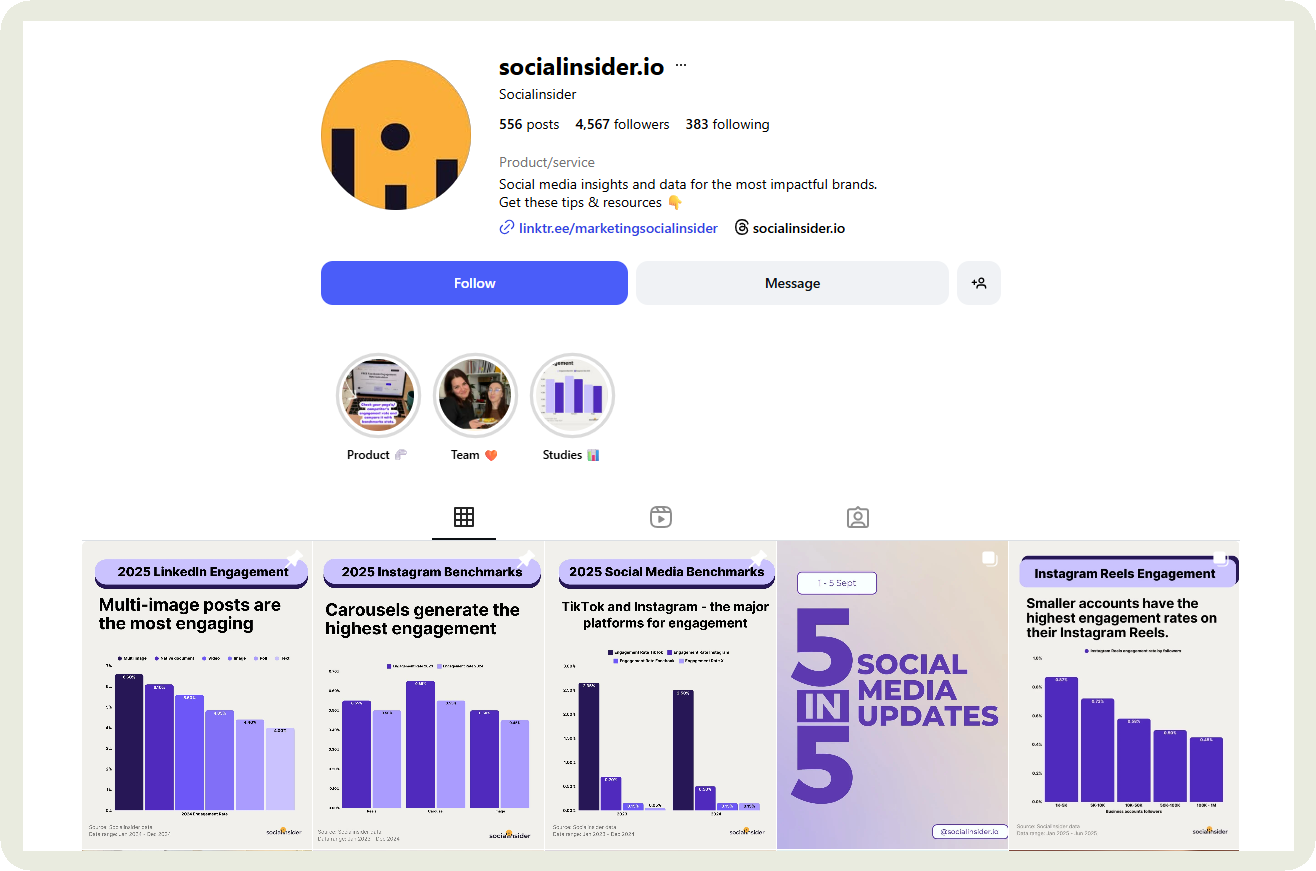
At the end of the day, your brand should have a unique, cohesive identity on Instagram. This is how you get recognized and remembered by followers.
If they get a sense of novelty perfectly combined with professionalism, then you are doing the right thing.
Step 3: Perform audience research
I love seeing that follower count tick upward. It feels like proof my content is landing.
But here’s the catch: growth without context doesn’t mean much. During an audit, I always zoom out to see who is actually following me and how fast that number is climbing.
To check follower growth rate, I like using Socialinsider because it shows growth in percentage over time, not just raw numbers. A spike after a new campaign? Good to know. A flat line for months? Time to rethink my approach.
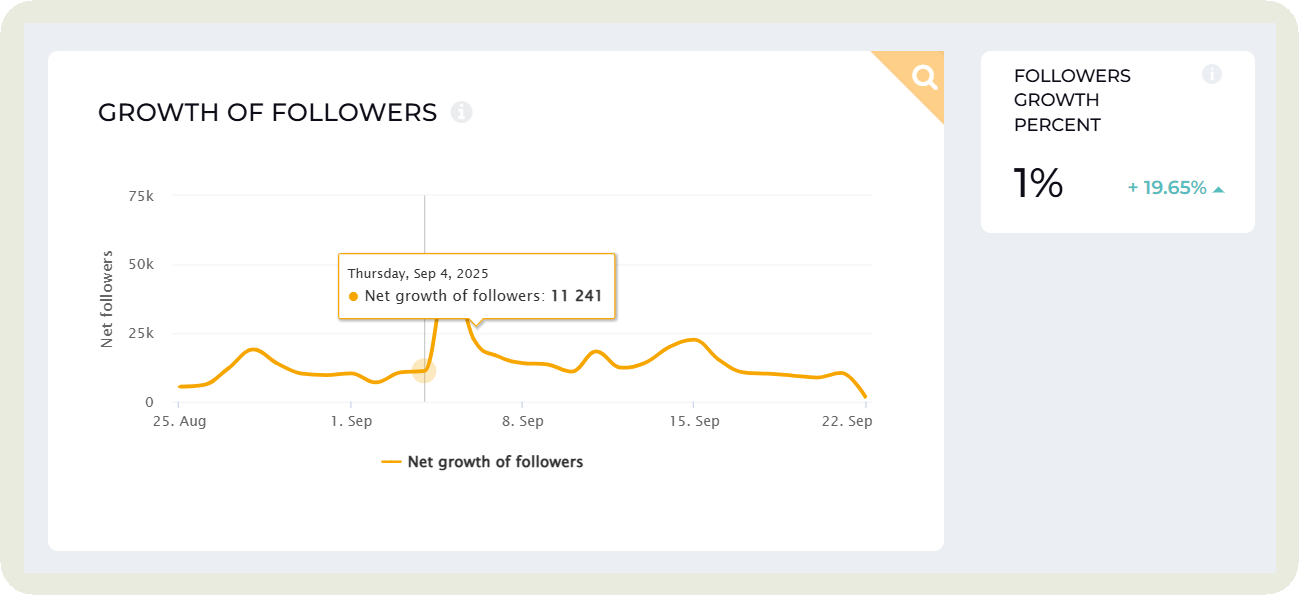
Then I zoom in. Instagram’s native analytics or Meta Business Suite gives me a snapshot of audience demographics. Age, gender, location, all the things that help me see if my audience actually matches my target market.
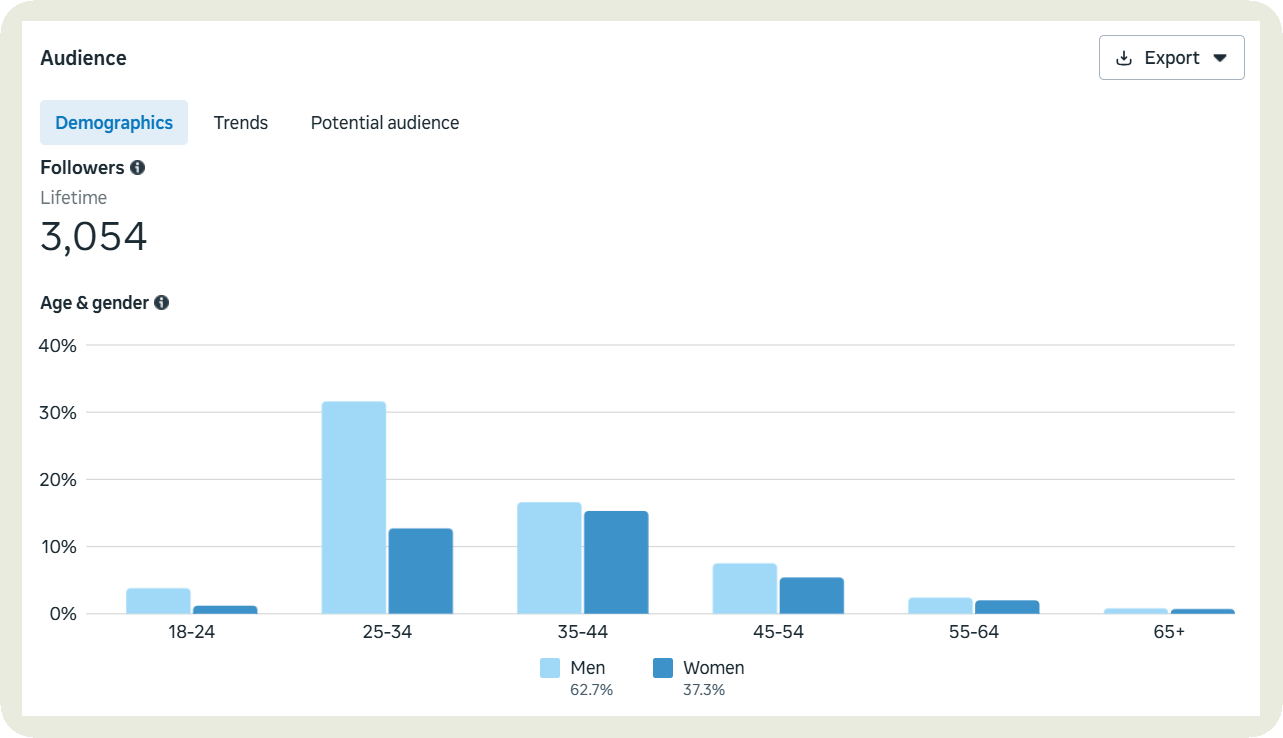
For example, if I’m trying to reach small business owners in New York but my biggest chunk of followers is students from another country, I know I’ve got some recalibrating to do.
And of course, I clean up my follower data. Fake followers are sneaky but easy to spot: no profile picture, odd usernames full of numbers, barely any posts. They inflate my count but add zero value. Clearing them out keeps my engagement rate honest.
The best part? Once this step is done, I know that any growth from here on out is both real and relevant.
Step 4: Review your Instagram content mix
Content is the main part of the audit process for every business. Instead of just looking at the posts, I follow a process that helps me gain insights quickly and easily.
Here’s how.
Analyze content formats
Instagram offers three formats to play with: Reels, carousels, and images.
With the popularity of Reels, you may be tempted to prioritize that over every other format. But what if your audience engages with carousels the most?
To check which format is getting the most engagement, I head to the Engagement section on Socialinsider and look at the data.
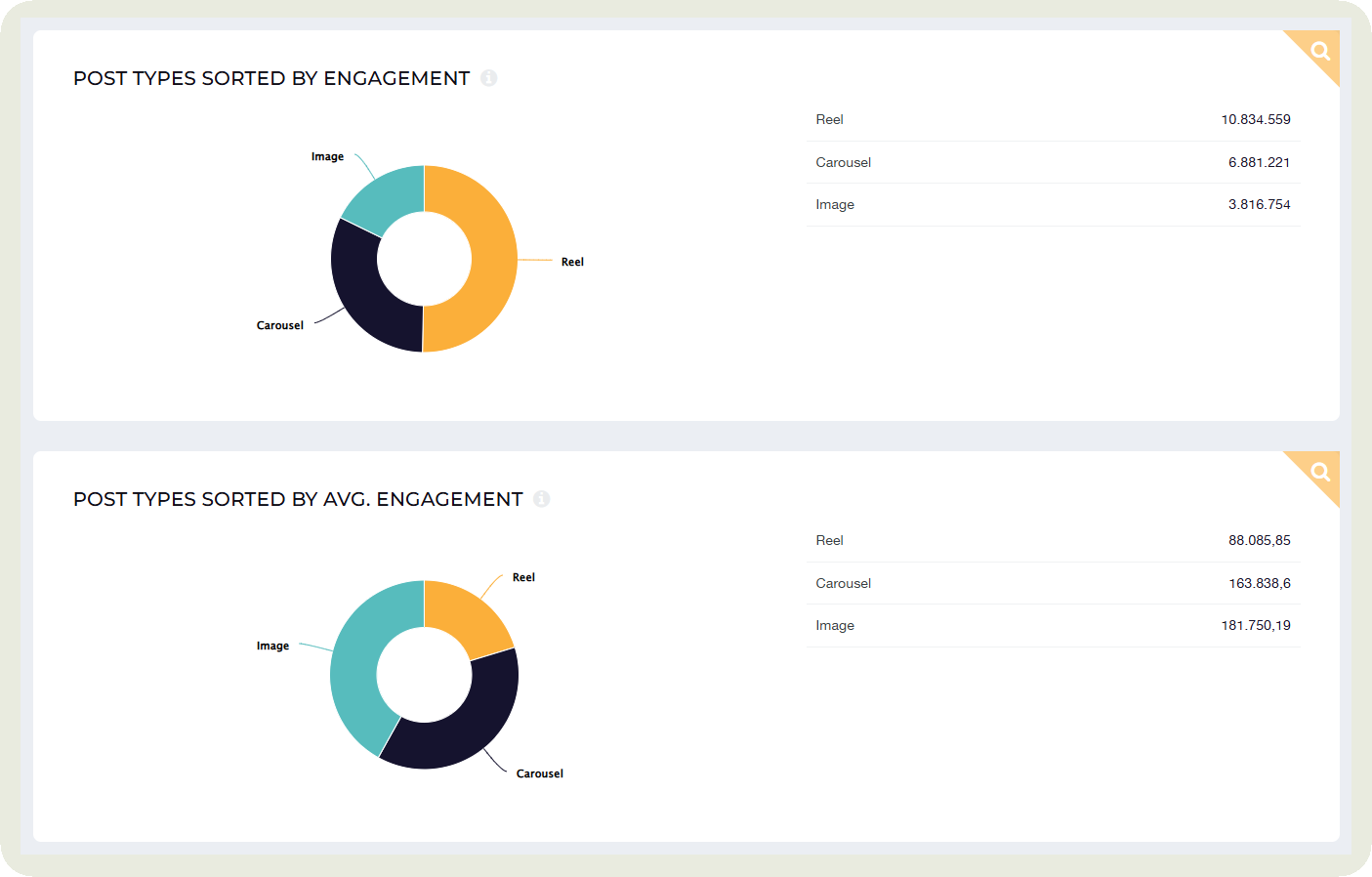
Based on this data, you can figure out where to put your efforts.
Check top-performing content pillars
Your content pillars are the backbone of your Instagram strategy. They tell you what stories and themes your audience actually wants more of.
Do people light up when you share behind-the-scenes snapshots, but scroll right past generic product posts? This is an indication that people want content that isn’t overly promotional.
Maybe you can try letting your users do the promotion for you. For example, Shopify partners with their users to create content that glorifies the product yet feels authentic.
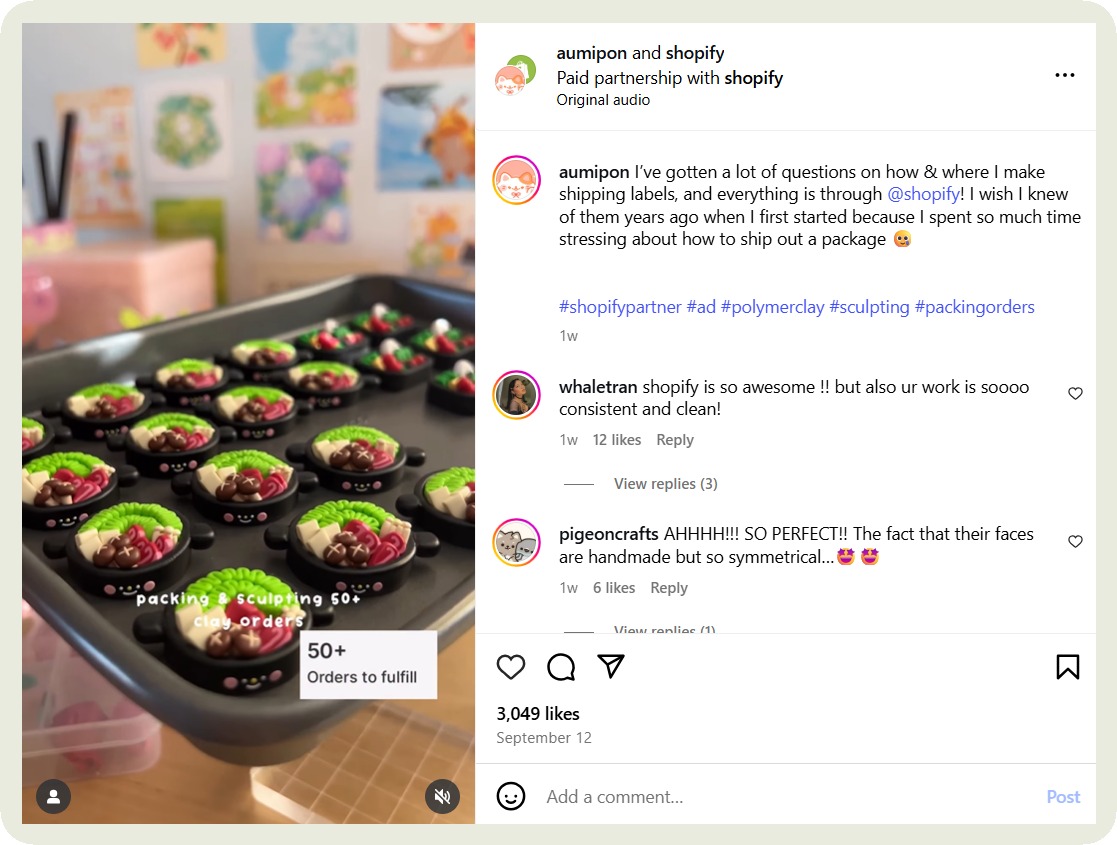
To know the data behind your content pillars, you can hop on to the Content Pillars section in our tool.
See which pillars bring the most engagement and how much value they generate for your brand. You can optimize your strategy accordingly.
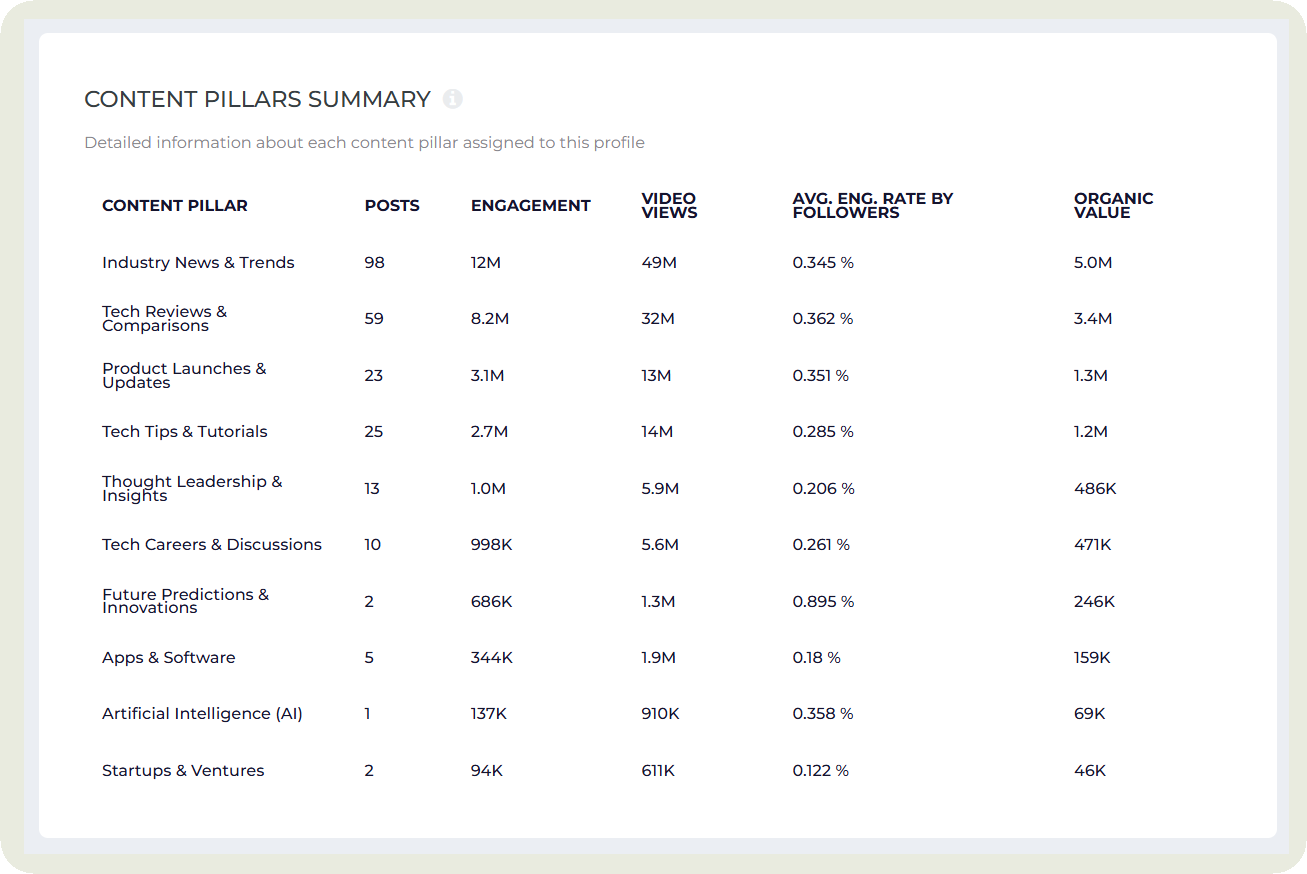
Georgia Gonzalez, social media manager at Penn State Outreach, talked about how auditing content pillars and formats helped them shape their strategy —
“When I run an Instagram audit, I always map performance back to content pillars, but the two metrics I focus on most are views and shares. That combo gives me a clear picture of what’s landing. A great example came from event promotion at Penn State Outreach. We used to rely on static flyers and photos, but those posts underperformed in both views and shares. The audit showed the problem wasn’t the events, it was the format. So instead of another flyer, we switched to quick POV-style Reels that walked people through the event experience. My intern Sadie created several of these, and we published them as Collabs on both the Outreach page and her personal account. The result was — views went up, shares multiplied, and engagement felt genuine.”
Look at trends over time
Sometimes, looking at just the past month’s data may not give you enough insights.
Take this example: maybe last month your Reels outperformed carousels by a mile. At first glance, you’d think, “Carousels are dead, let’s go all in on Reels.” But when you compare a longer stretch, say three to six months, you might notice carousels were once your biggest drivers of shares and comments.
So what changed? Did the format itself lose steam, or did your content angle shift in a way that stopped clicking with your audience?
By tracking trends over time instead of chasing short-term spikes, you’ll see the bigger patterns. Which formats are truly rising, which are just in a slump, and which need a fresh creative approach. Think of it as spotting the difference between a seasonal dip and a long-term decline.
Step 5: Check content quality and performance for each format
Each format on Instagram is unique in its own way. That’s why you should measure them individually. Here’s a checklist you can follow to track if you’re doing your best for each format.
Monitor Reel performance
- Are we hooking viewers in the first 3 seconds?
- Are we adding subtitles for people watching on mute?
- Are we using trending sounds that fit our brand?
- Do our Reels have a natural loop or replay value?
- Are we mixing educational, entertaining, and promotional content?
You can check your Reels data in Socialinsider to get data to guide your Instagram strategy.
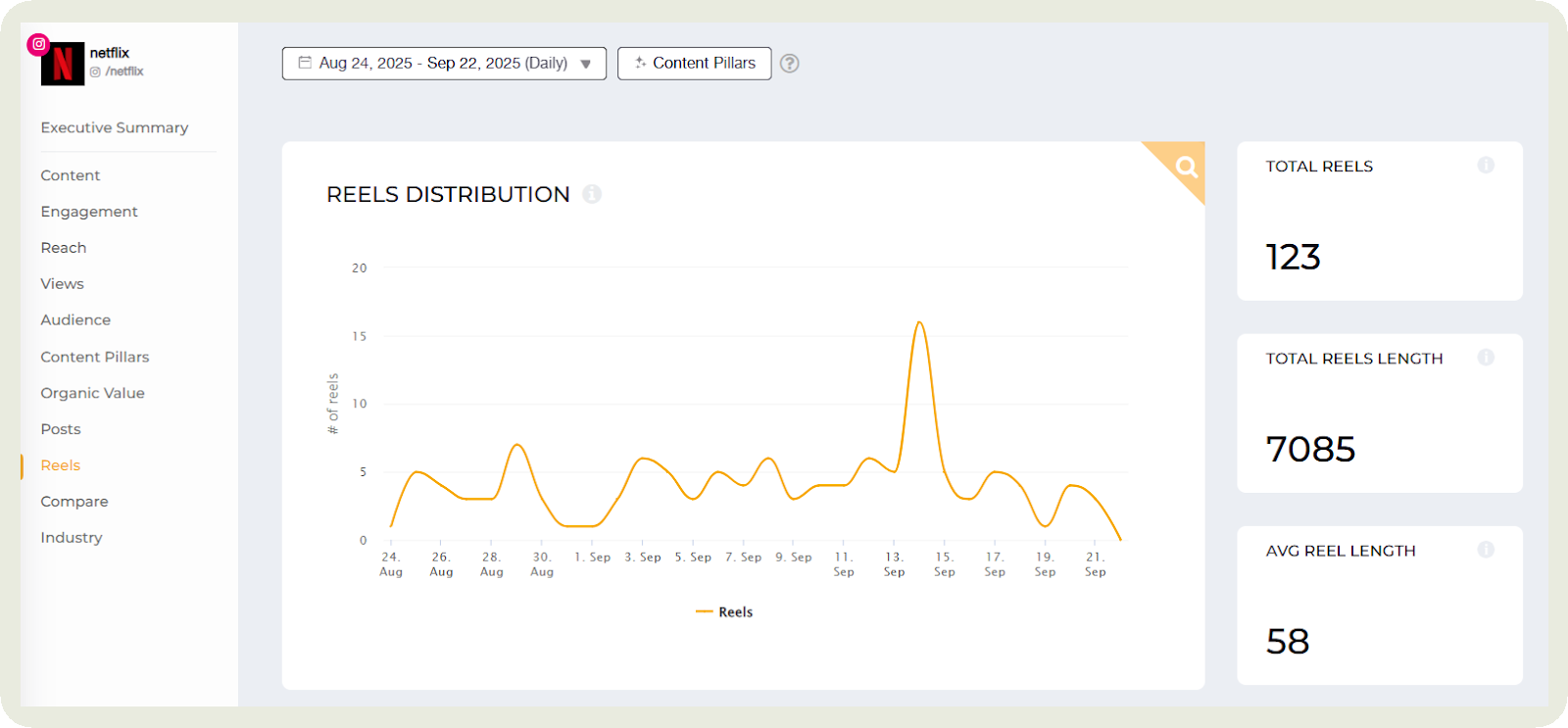
Check carousel performance
- Is the first slide eye-catching enough to stop the scroll?
- Do we tell a story or share tips in a logical order?
- Are we keeping slides clean, with minimal text per frame?
- Do we end with a clear CTA (save, share, click, follow)?
- Are the visuals and fonts consistent with brand style?
Check Image post performance
- Are our visuals high quality and on-brand?
- Do captions add context, value, or storytelling (not just filler)?
- Are we creating graphics that people want to save or share (quotes, stats, tips)?
- Are we varying image types (product, lifestyle, user-generated, behind-the-scenes)?
- Do images stand out in the feed (contrast, bold visuals, clear design)?
Instead of manually checking these posts, I filter posts by images on Socialinsider for a certain time frame and check for all these elements.
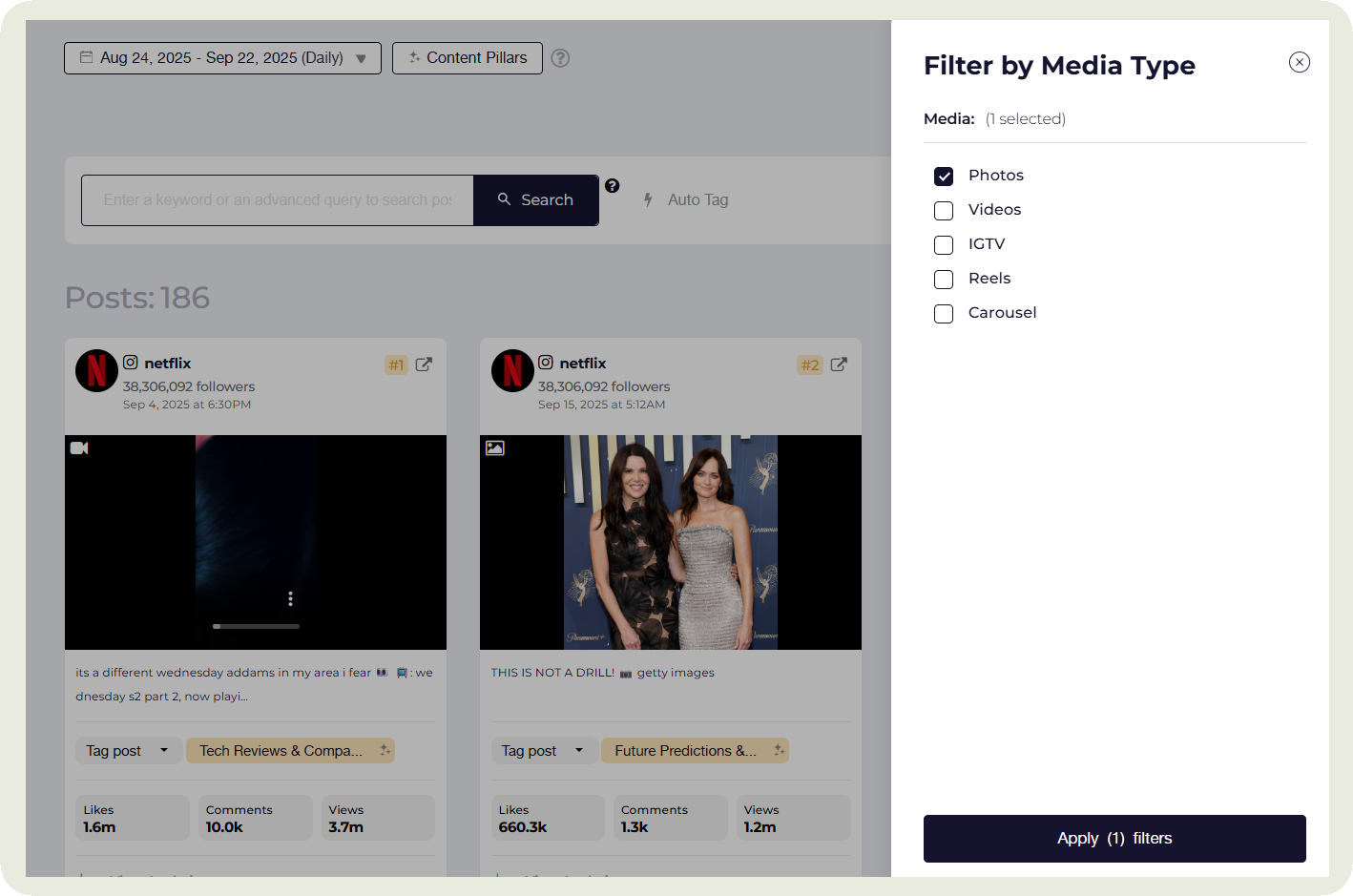
Step 6: Assess your engagement data
One of the easiest ways to check if your strategy is working, as part of an Instagram page audit, is to check your engagement levels. That way, you will begin to understand if your audience is responding to your content the way you want it to.
You can do this by looking at Instagram’s native analytics, but for a full picture, use a social media analytics tool like Socialinsider.
You can get to know engagement in all its variations - total engagement, engagement rate, engagement by reach, and post types by engagement. Each one of these will give clues on how invested your followers are in the content you share.
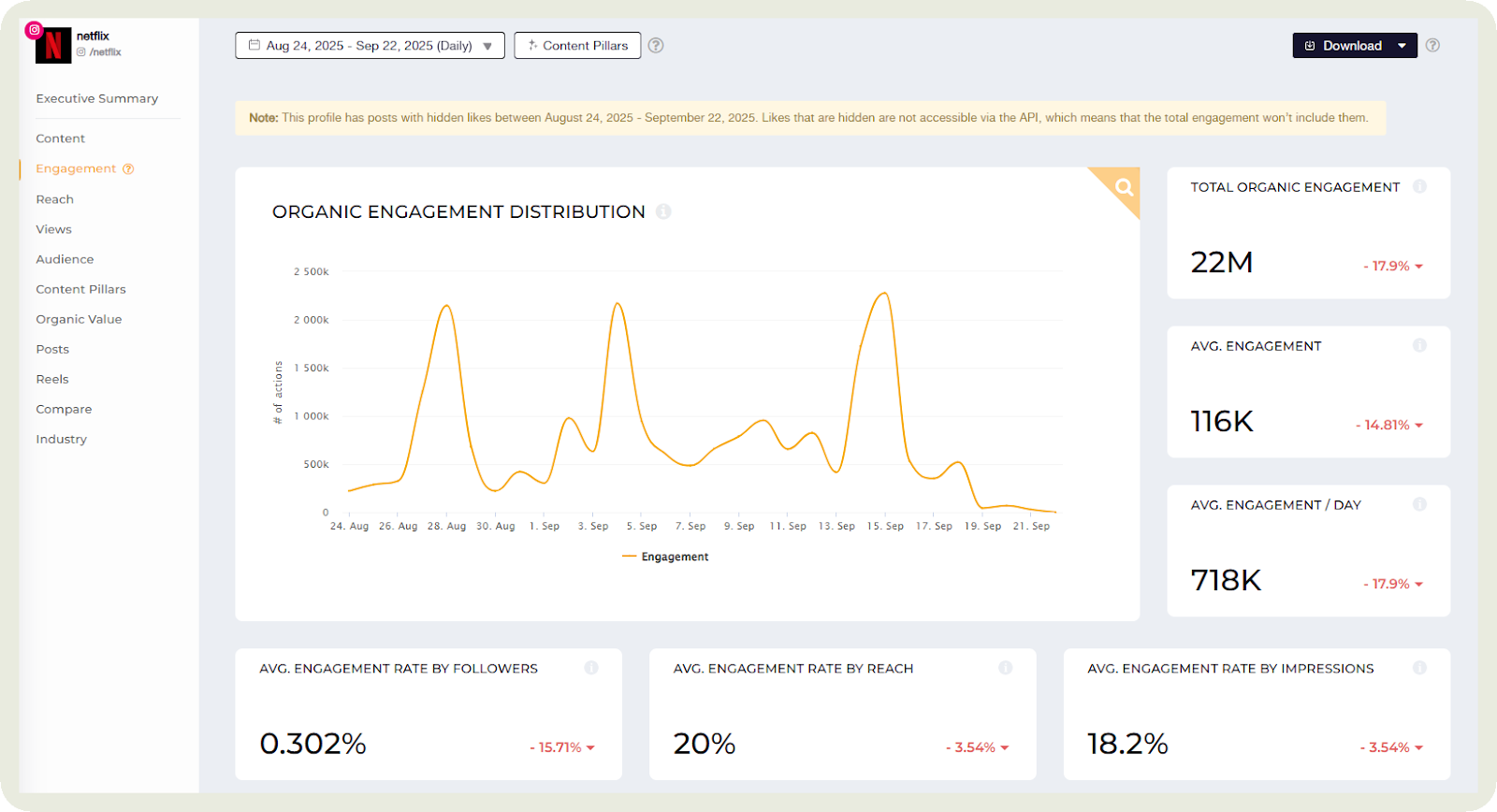
I would also recommend checking for qualitative engagement data. For example, which posts are getting a lot of shares and saves? Are you interacting with comments on your posts?
The stronger your qualitative engagement, the stronger your community and, in turn, your brand’s presence on Instagram.
Step 7: Examine your posting frequency
How often do you post? Once a week? Every day? Randomly, whenever inspiration strikes? Posting frequency is more about consistency than volume. The algorithm favors accounts that show up regularly, and your audience does too.
The real question is: what’s the best time and frequency for your brand? The truth is, there’s no universal magic number. Some brands thrive on daily updates, while others see better results with three solid posts a week paired with active Stories.
To figure this out, I always start with the data. Head to Socialinsider and check when your audience is most active. The tool looks at your past performance and tells you which day and time slot brings the highest engagement. That’s gold.
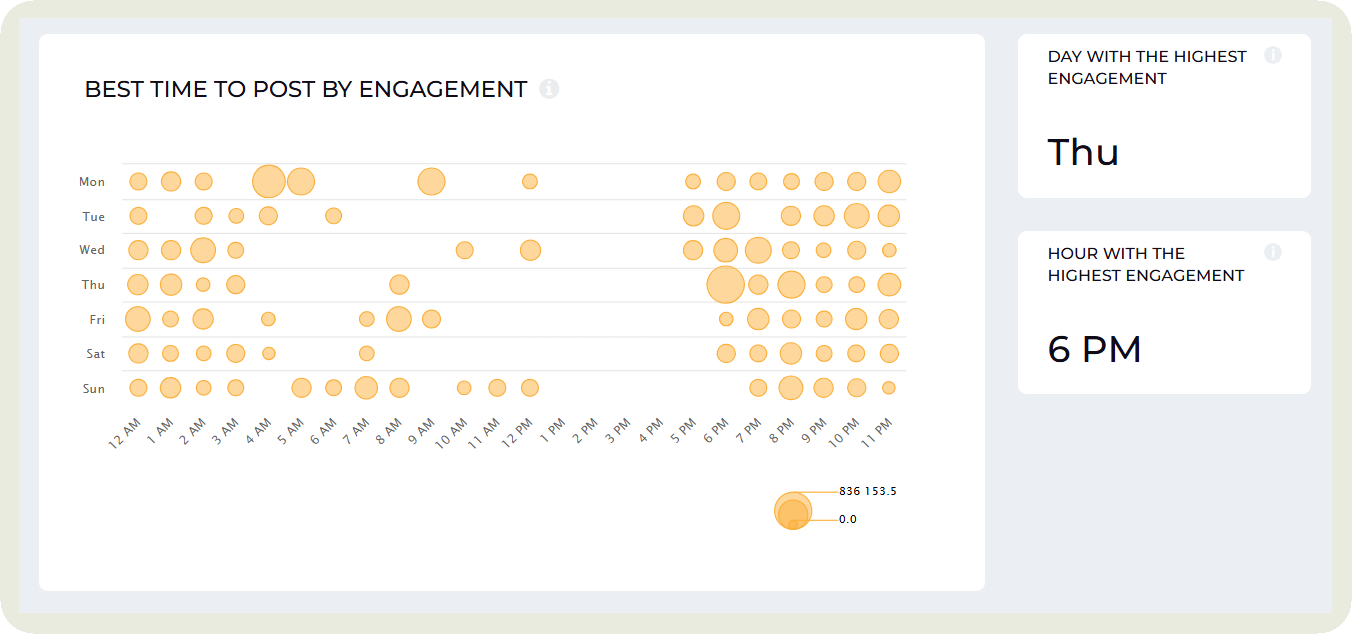
I also recommend checking whether you’re posting too much or too little. If engagement drops when you increase volume, you may be overwhelming your audience. If you’re posting too rarely, you risk becoming forgettable in their feed.
The sweet spot comes from testing. For example, if I see that posting three times a week is driving more saves and shares than posting five times, I’ll stick to three and focus on quality. And I’ll use Stories to keep my presence steady in between.
Step 8: Review your hashtag strategy
If you are using hashtags, make sure you choose the popular ones in your industry, those that are in line with your products and interests.
Use a mix of niche hashtags and branded hashtags to transform the name of your brand into a star.
If you are one of the users wondering whether to put your Instagram hashtags in the caption or in the first comment, you should know that either of these is ok.
Keep in mind that community-oriented hashtags, hashtags that are relevant to your industry, can help you get noticed by your target audience.
And most importantly, as part of your regular Instagram account audit, keep tabs on your hashtag performance to see which ones perform best.
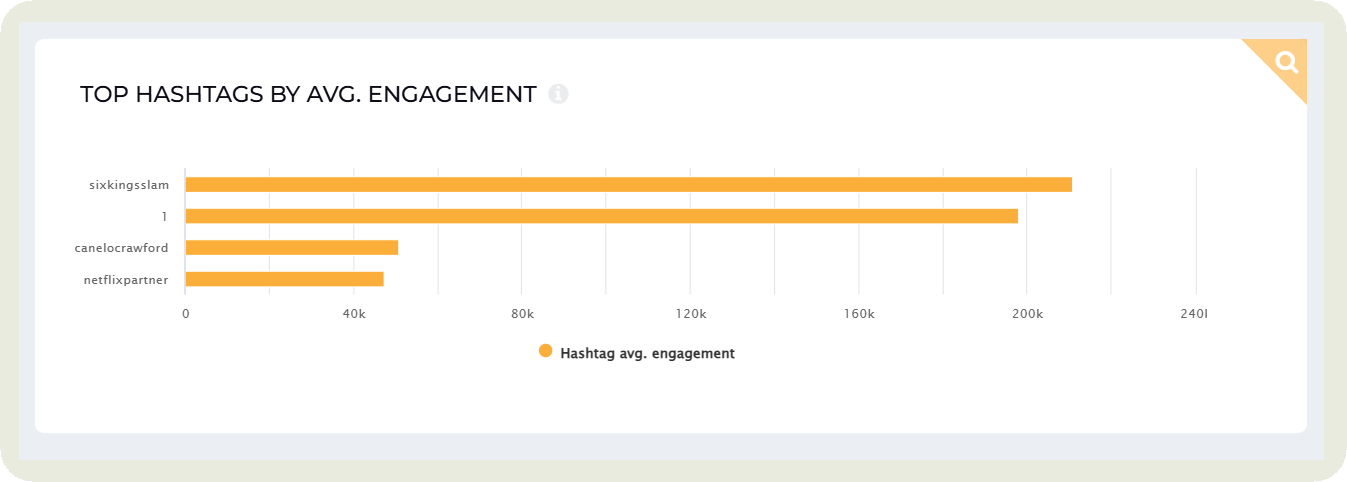
Step 9: Perform a competitive analysis
Even though you’re focused on auditing your own profile, it’s smart to dedicate a small section to competitor analysis.
A quick scan shows you what’s working for them, where they’re getting traction, and whether the strategies you’re planning actually hold up in the broader competitive space.
Instead of spending hours pulling data manually, you can use Socialinsider to get a quick competitor snapshot. Here’s what the benchmarking feature gets you.
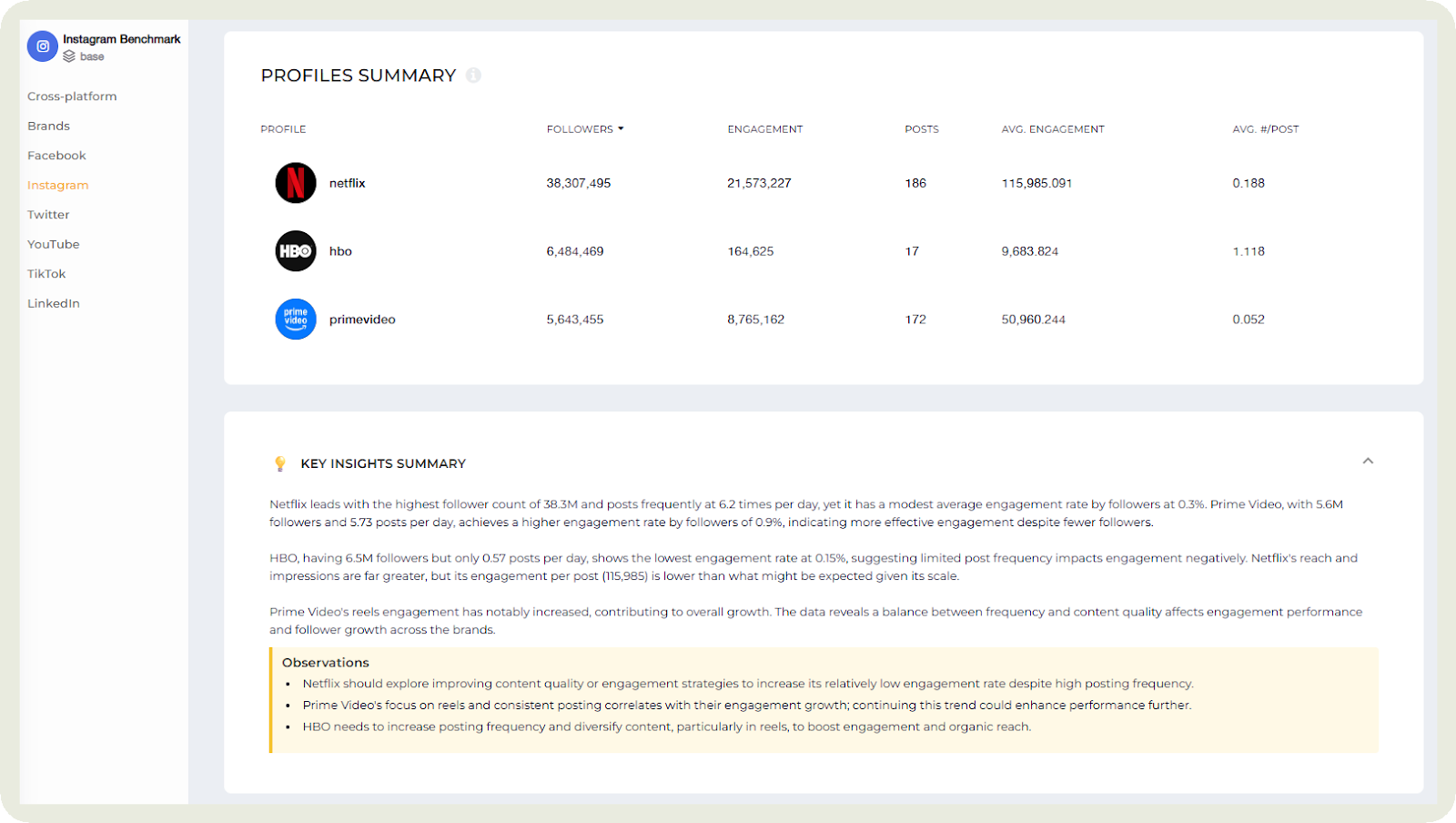
The Key Insights Summary is my go-to. It highlights not just what competitors are doing, but also where the gaps are that I can use to my advantage.
I also love the side-by-side comparison features. You can pit your brand against competitors on metrics like organic reach, follower growth, engagement rate, or posting frequency.
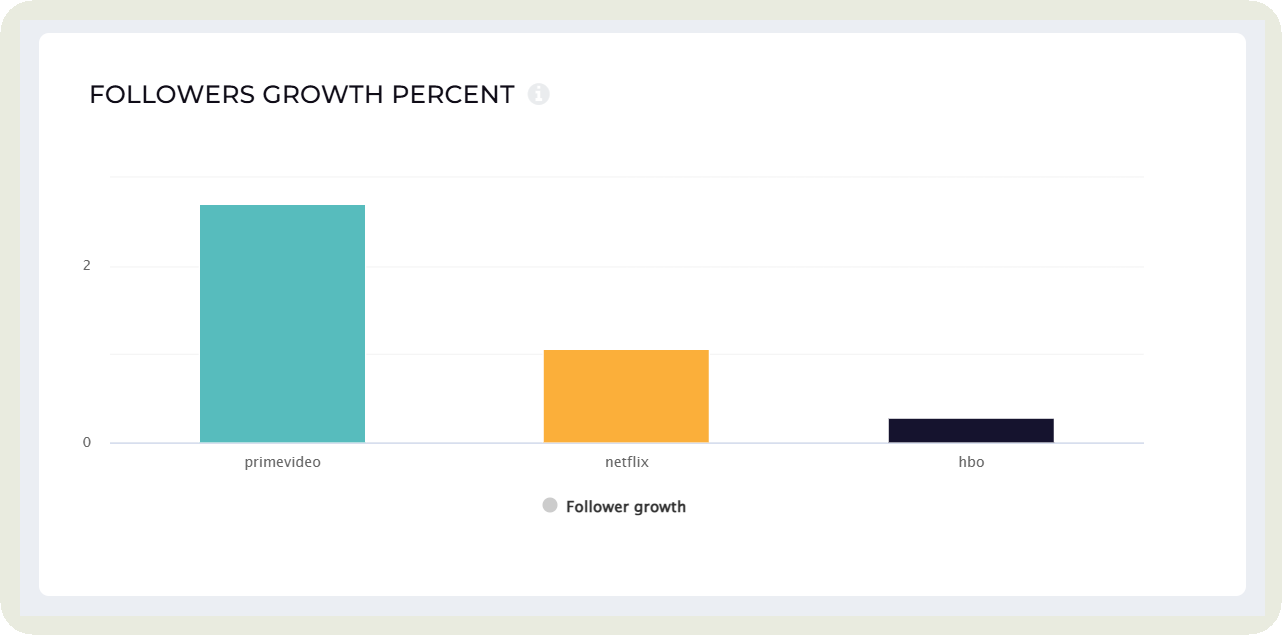
This step in your Instagram audit should give you confidence that the strategies you’re about to refine or roll out will work.
Step 10: Compile all your findings
An audit isn’t complete until everything you’ve uncovered is pulled together in one place. Scattered notes and screenshots won’t do much good if you can’t see the big picture. That’s why the final step is to compile all your findings into a single report or dashboard.
I structure mine with a clear list of action items that we need to take. For example: “Update bio link with current campaign,” “Double down on Reels, reduce static posts,” or “Test posting 3x per week instead of 5x.”
You should also add the results you think you’ll achieve with these strategies. This audit report will make it easy for your team and managers to be on the same page.
10 tools to perform an Instagram audit
Now that you’ve learned how to perform an Instagram audit for your brand, you should also know what tools could help you in the process.
Here’s a list of top Instagram audit tools that can be crucial in your process of reviewing your Instagram strategy.
1. Socialinsider
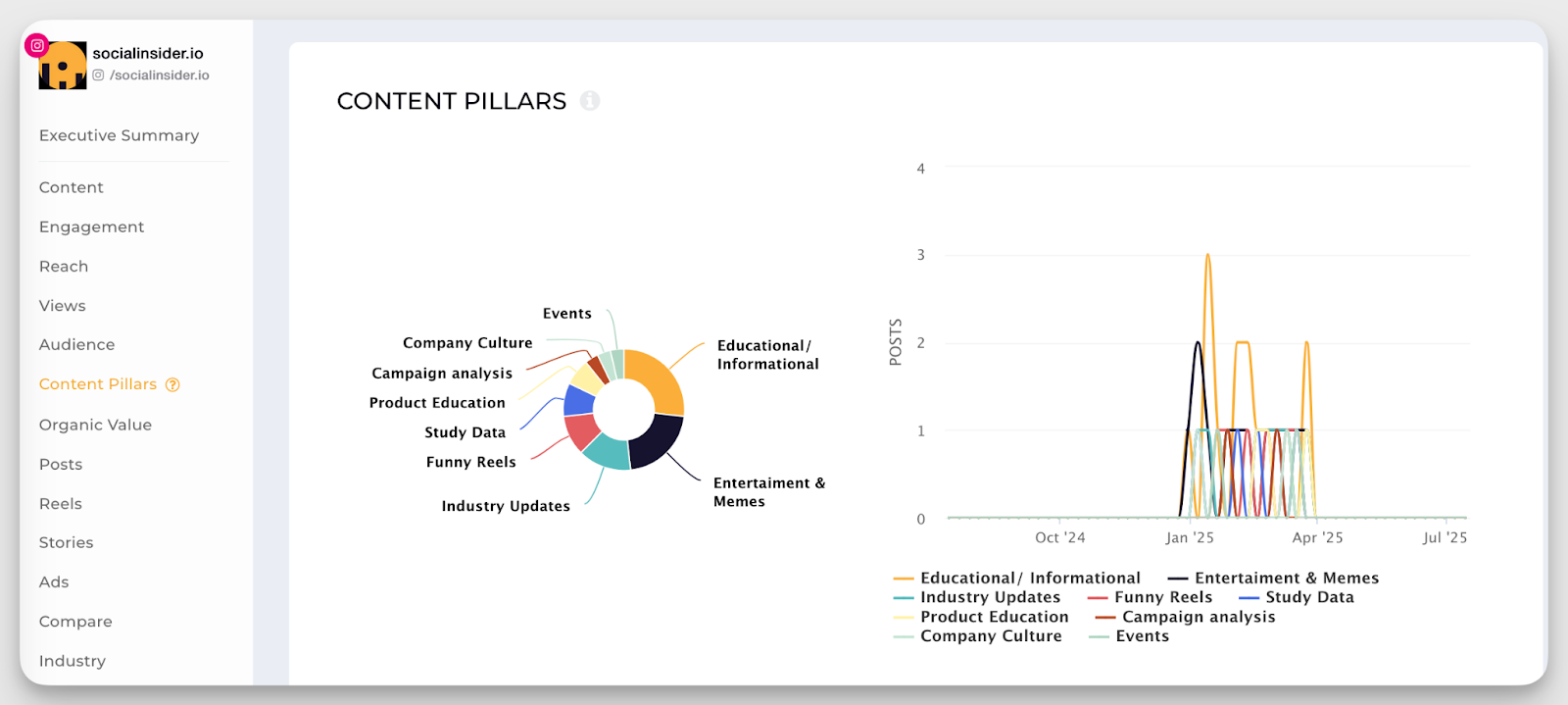
Socialinsider is a top-notch analytics tool that can be extremely useful in conducting an Instagram account audit. The tool is also adaptable when it comes to performing any kind of social media audit, pulling data from a massive database.
2. Brandwatch
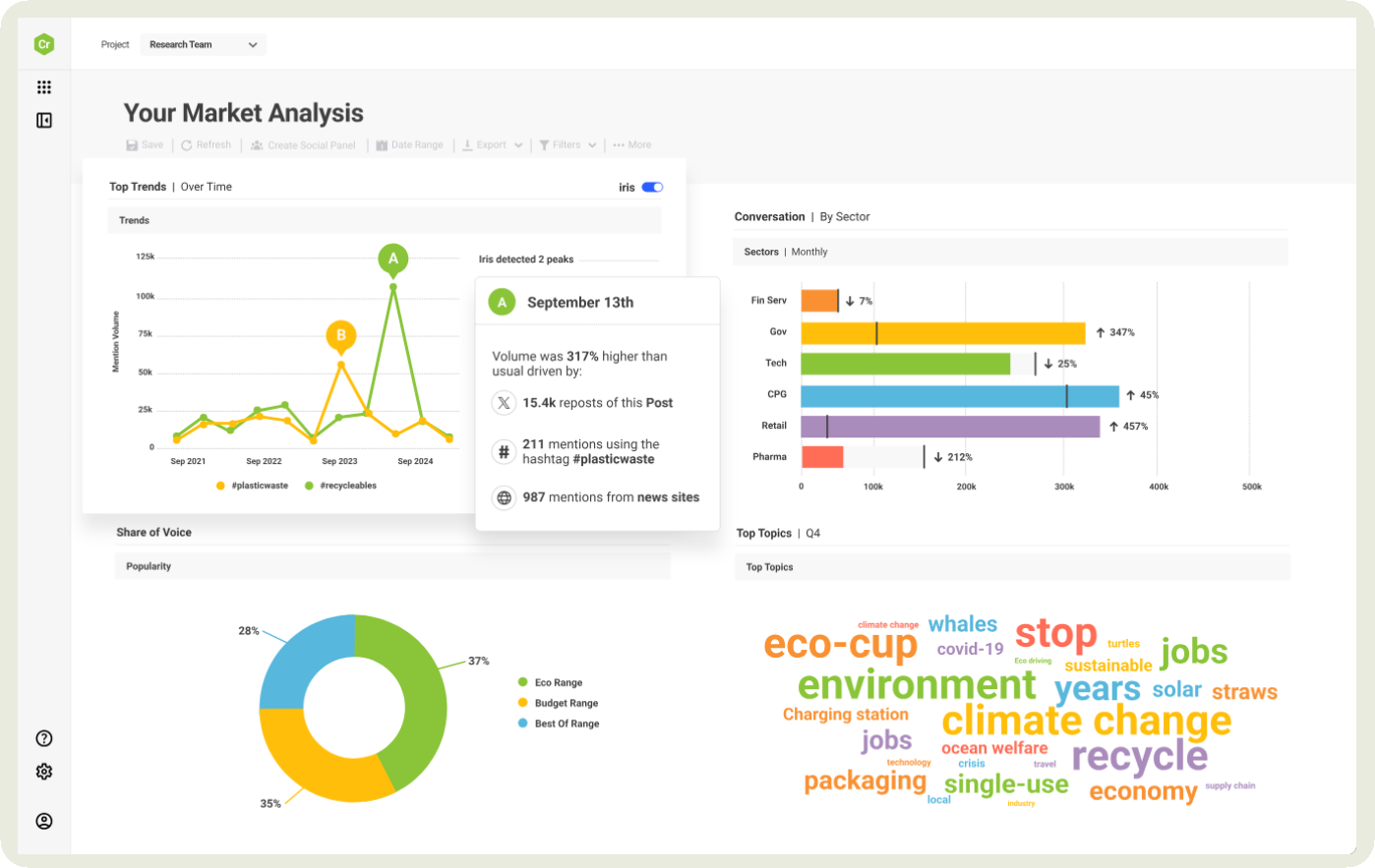
Another useful Instagram audit tool is Brandwatch. This app offers you a lot of insights regarding the best posting times. Also, you will find a lot of guidance for the hashtags you should use according to your niche.
3. Sprout Social
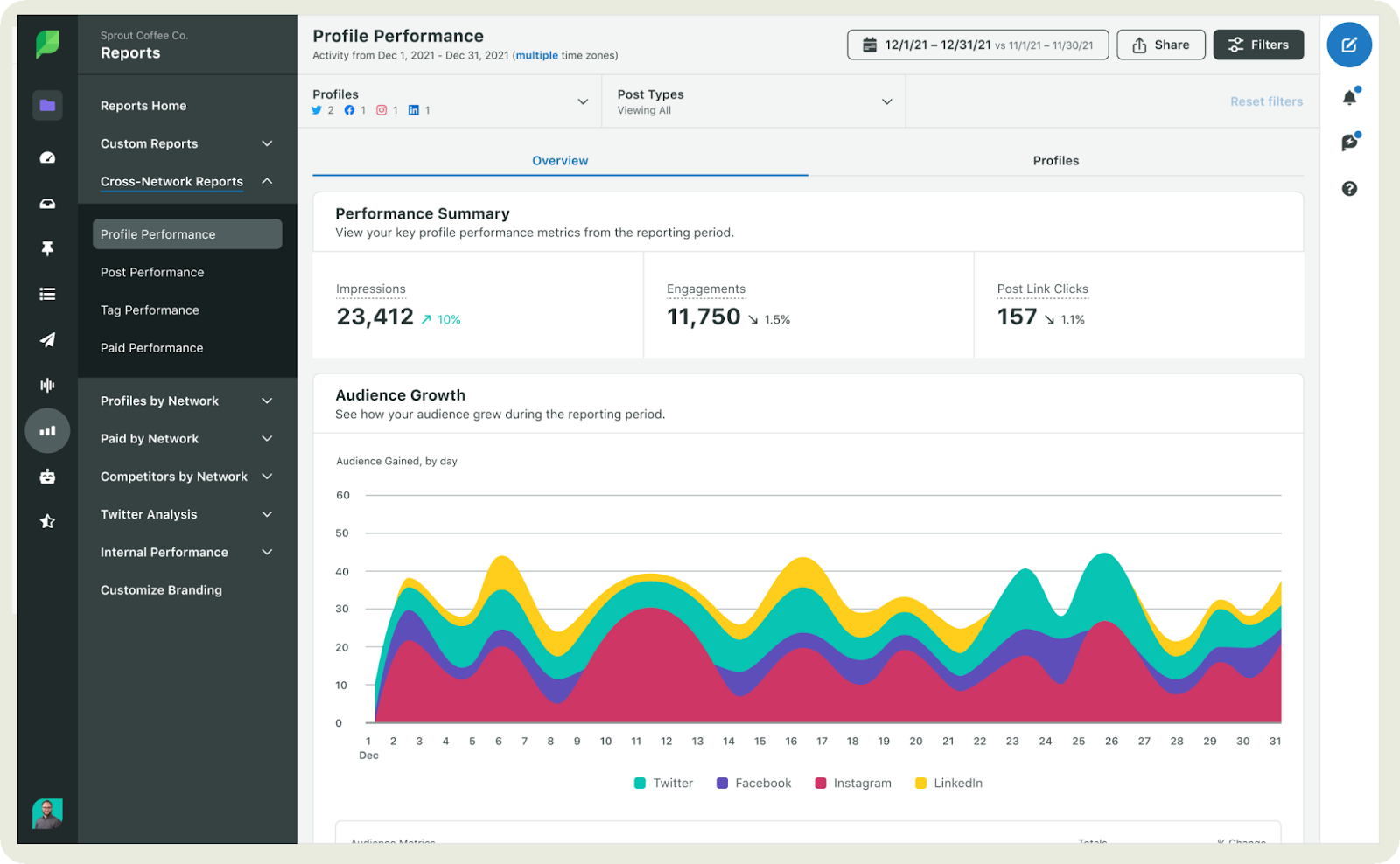
Sprout Social is one of the best tools for conducting an Instagram audit. With this app, you are going to discover how to assess your Instagram performance depending on the specific timespan you set.
4. Phlanx
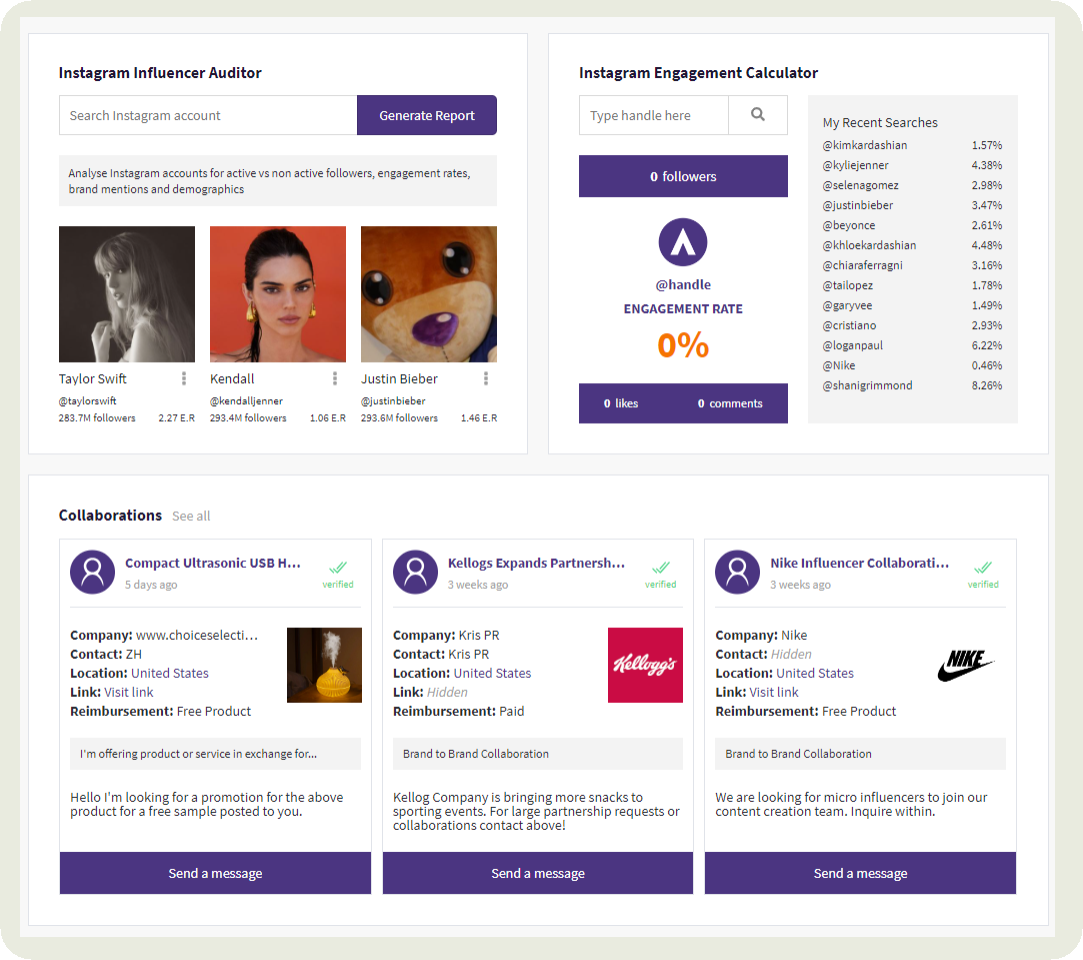
Phlanx is a tool that can really ease your marketing job. Besides helping you establish collaborations with influencers and assessing an Instagram influencer audit, you can also audit your brand’s profile.
5. Emplifi
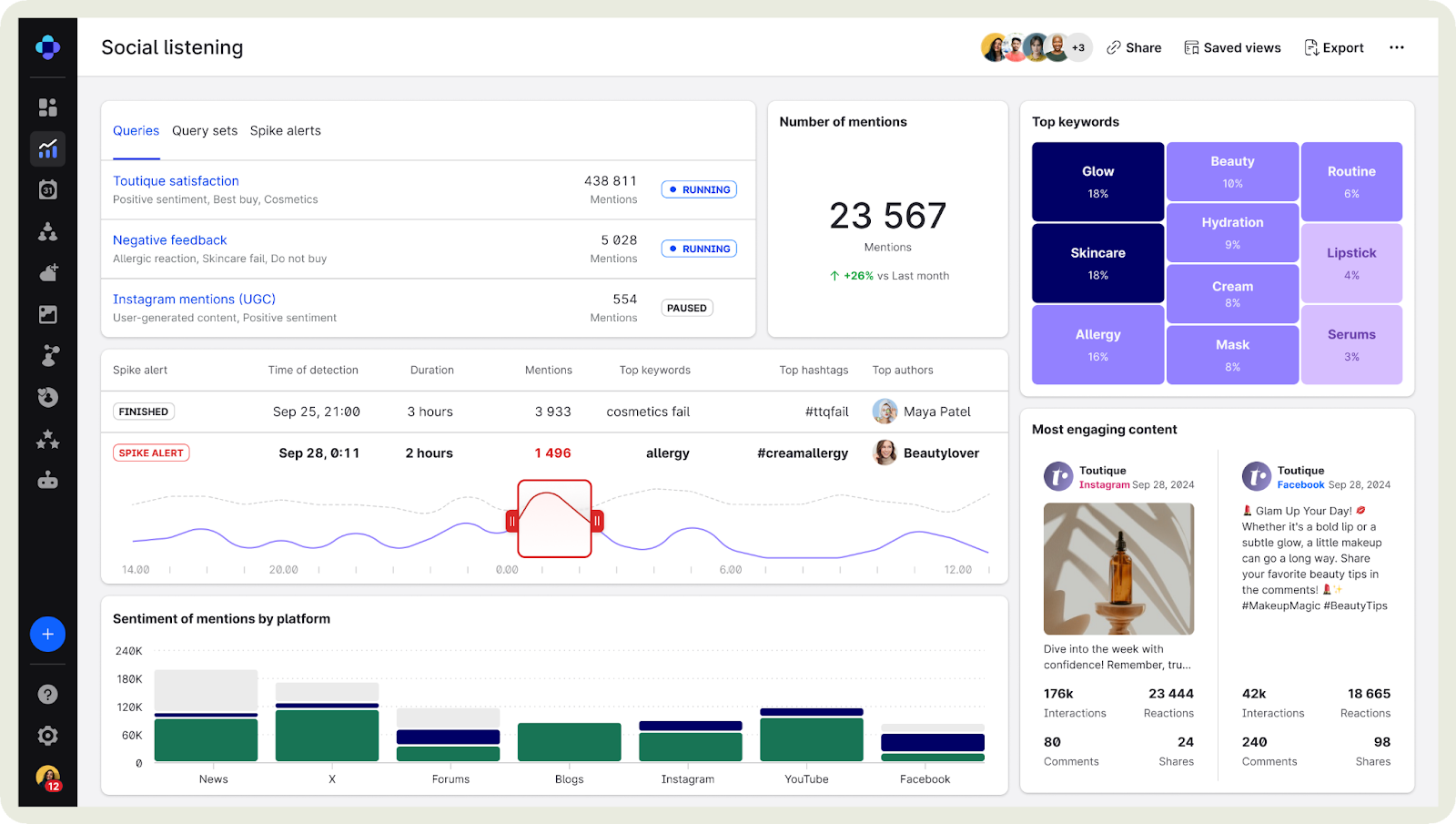
Emplifi is a marketing platform that offers you numerous tools to analyze your social media performance, including an Instagram audit. The tool provides statistics about your Instagram account, helping you keep a close eye on your evolution.
6. Smartmetrics
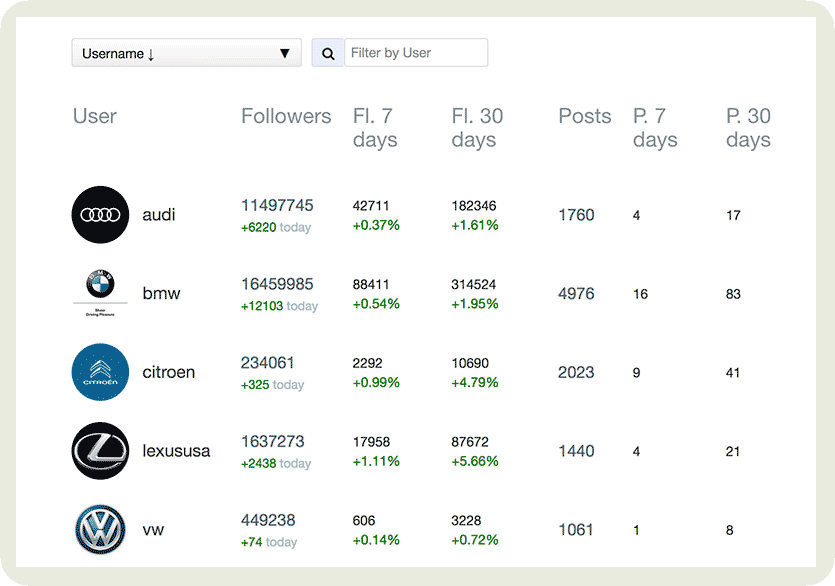
Smartmetrics is an Instagram audit tool that can offer over 30 metrics for your brand’s account. So you get in-depth details about your content’s performance while your campaign unfolds.
7. Minter.io
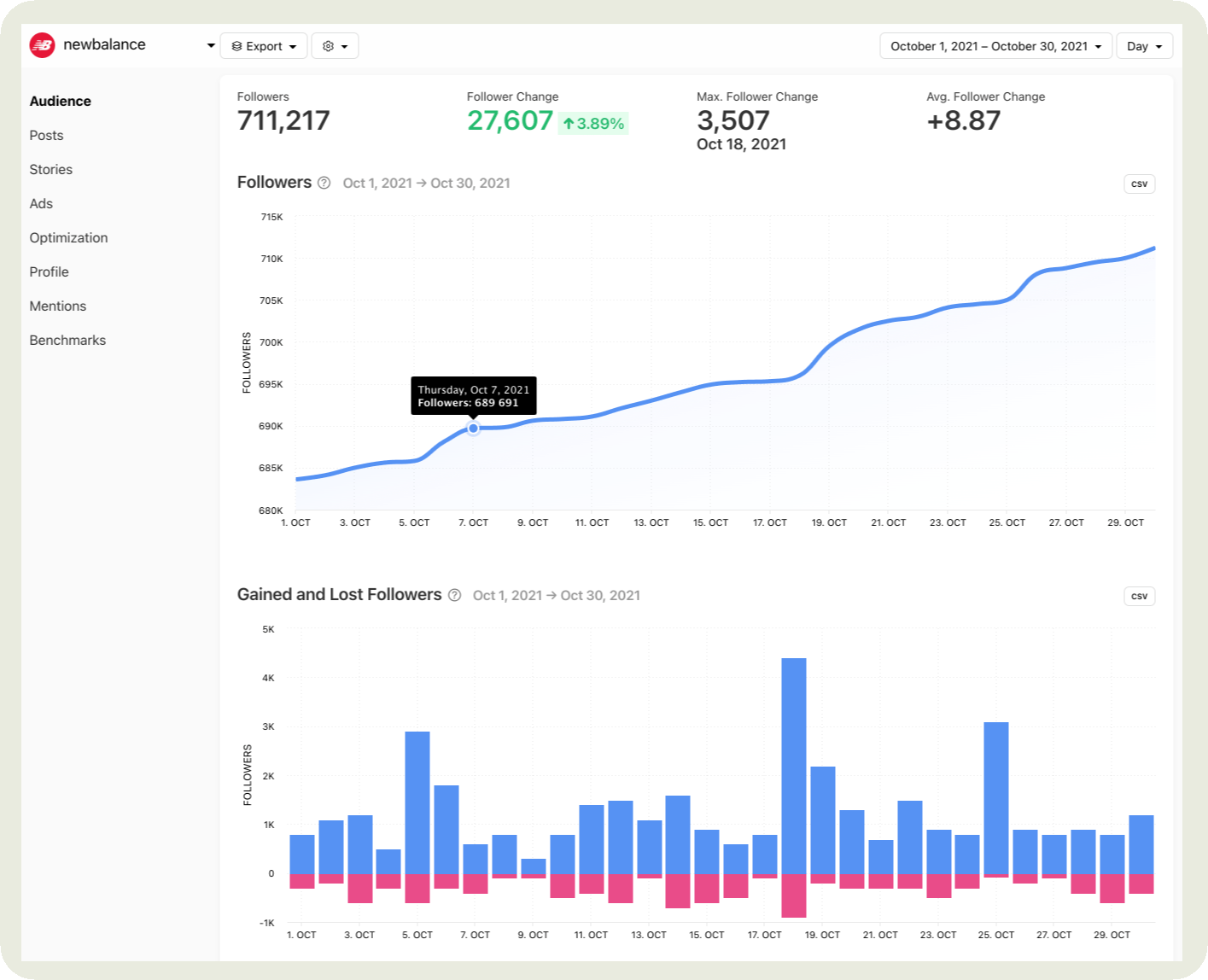
With Minter.io, you get data about your brand’s growth, popular Instagram metrics like engagement and views, demographics, and reach rate. Basically, you obtain all the needed data to conduct an Instagram audit.
8. Iconosquare
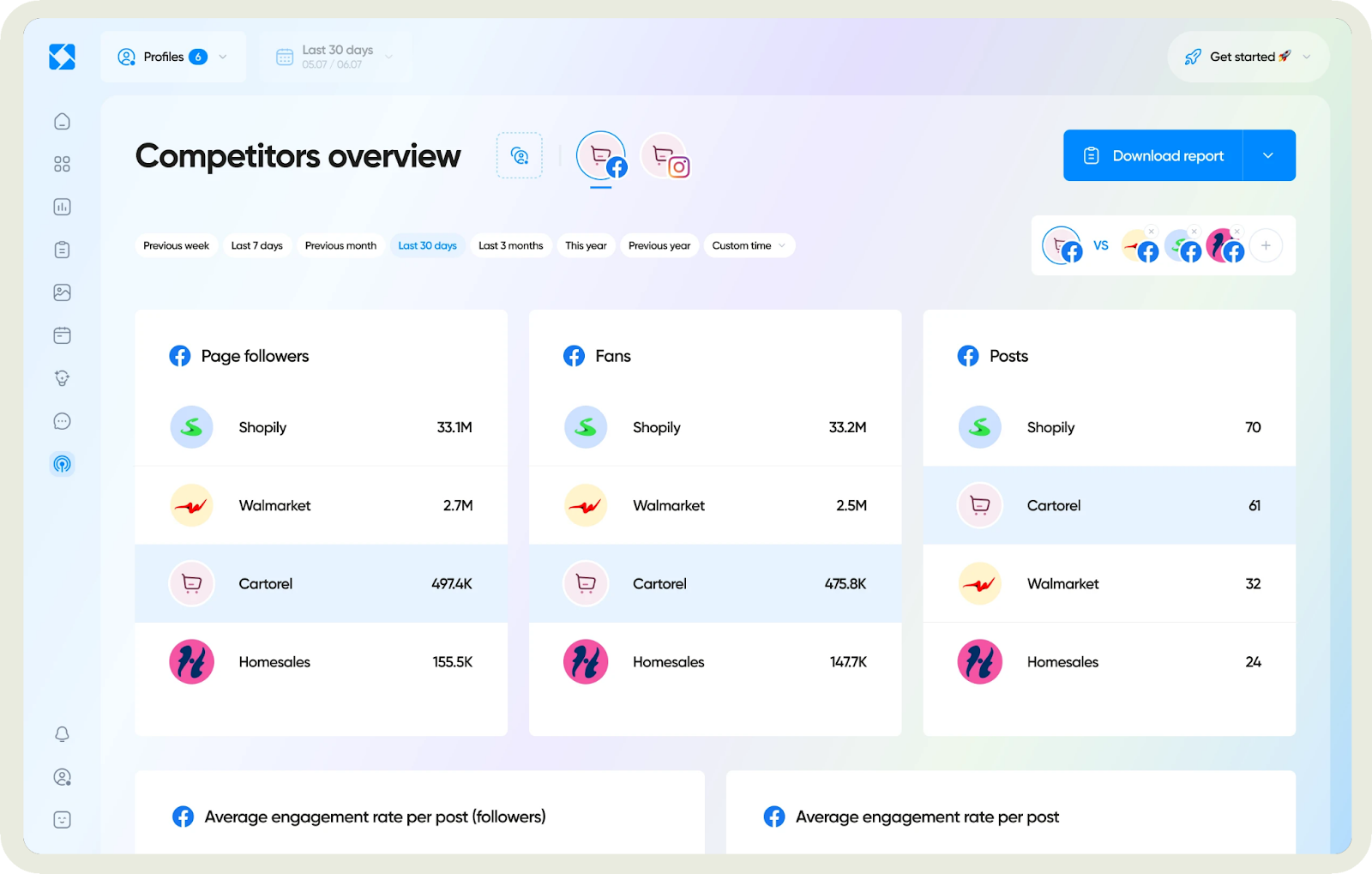
Iconosquare is another Instagram audit tool meant to help you gain insights during your marketing campaign. The app is also equipped with a unique function that sends you a review of your strong and weak points. Isn’t that fantastic?
9. HypeAuditor
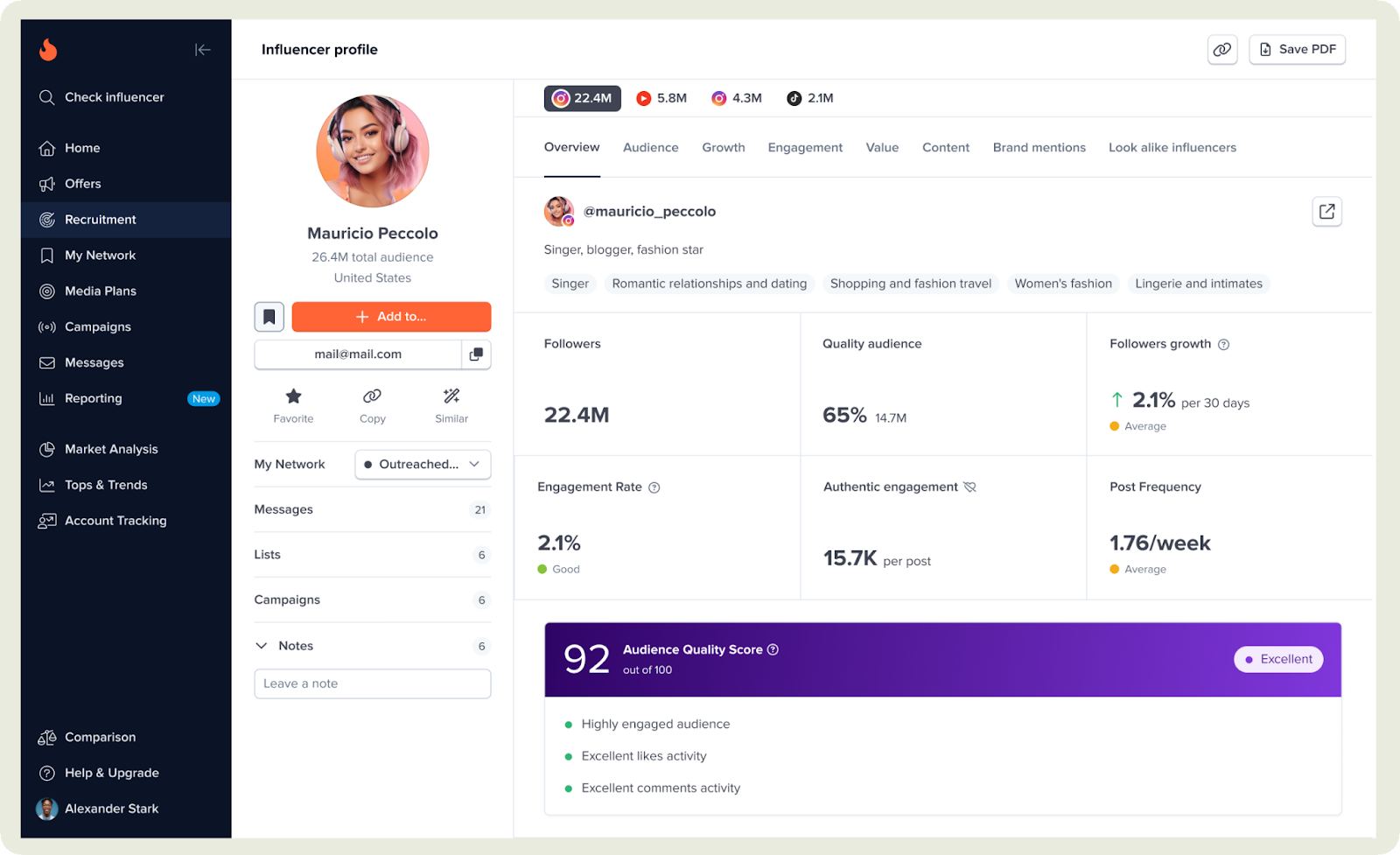
HypeAuditor is suitable for both Instagram and YouTube audits, offering you in-depth information about your brand’s accounts. The data could be easily included in your report when developing your Instagram audit.
10. Quintly
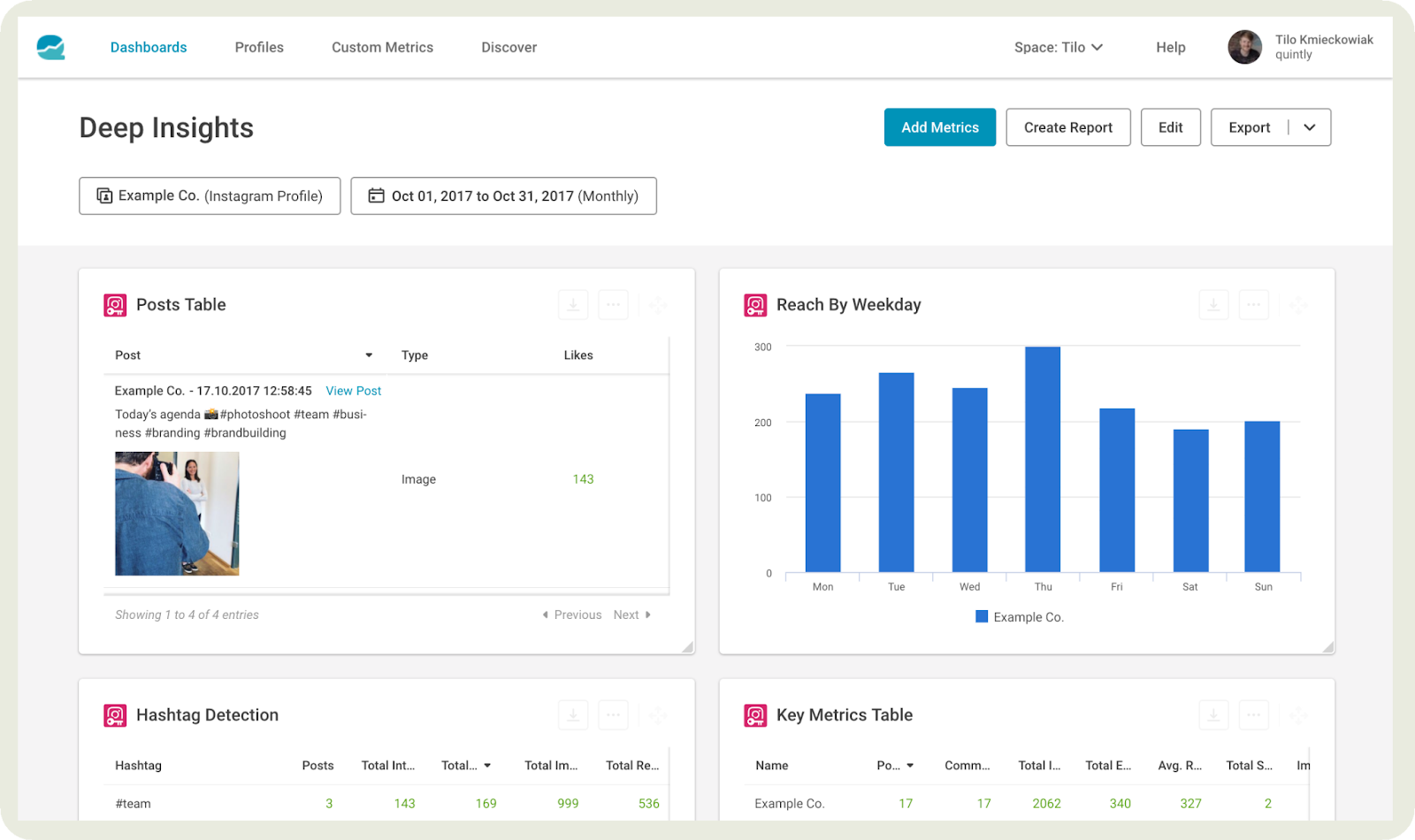
Another useful analytics tool for your business is Quintly. The app offers you the chance to develop your audit based on the KPIs you set for your brand. It can assess more than 350 metrics to help you really get a grip on your Instagram performance.
Final thoughts
With the help of an Instagram audit, you can easily decide what changes you need to make for your Instagram marketing strategy.
This type of thorough analysis, leveraging social media analytics to closely examine the results of your posts, helps you better understand your audience and learn more about how much you can expand.
By performing an Instagram audit, you will be able to get the broader picture about your brand, the quality of your work, and how your products and services are perceived by your clients.
If you need an analytics tool that makes this job easy for you, try out Socialinsider for free.
FAQs about Instagram audit
1. What questions should I ask in an Instagram audit?
Some of the most important questions you should ask yourself during an Instagram audit are:
- Is my profile bio up to date with the latest business information, and does it include all the key links to my website?
- Does my Instagram grid have a strong, on-brand visual identity?
- How many followers have I gained, and what is my follower growth rate? Are any of them fake?
- How engaging is my Instagram content? Which content format brings me the highest levels of engagement?
- How relevant is my content to my target audience?
- Is my hashtag strategy working? If not, how can I improve it?
- What are my goals for Instagram, and how close am I to meeting them?
2. What is the Instagram audit report?
An Instagram audit report is just a document / spreadsheet / slide deck that includes all the data and findings of your Instagram audit.
3. How often should you run an Instagram audit?
You don’t need to run an Instagram audit every week, but you shouldn’t leave it for once a year either. A good rule of thumb is quarterly, so you can spot trends, fix issues, and adjust your strategy before small problems turn into big ones. If you’re growing fast or testing new campaigns, a monthly mini-audit can keep you on track.
4. What are the benefits of running an audit?
Running an Instagram audit helps you see what’s working, what’s wasting effort, and where you can improve. It highlights your best-performing content formats and pillars, shows if your audience actually matches your target market, and helps you catch issues like fake followers or broken links. Most importantly, it turns raw data into clear action items that sharpen your strategy and boost results.
Analyze your competitors in seconds
Track & analyze your competitors and get top social media metrics and more!
You might also like
Improve your social media strategy with Socialinsider!
Use in-depth data to measure your social accounts’ performance, analyze competitors, and gain insights to improve your strategy.




